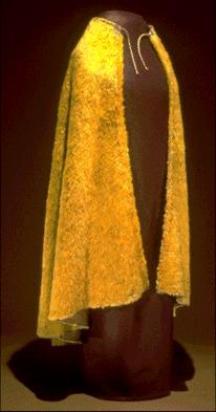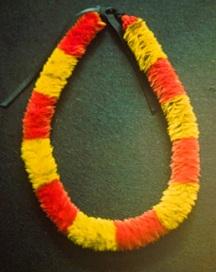Digital Collections
Celebrating the breadth and depth of Hawaiian knowledge. Amplifying Pacific voices of resiliency and hope. Recording the wisdom of past and present to help shape our future.
Melehina Groves [Ka‘iwakīloumoku]
Ka wela o ka ua.
Heated rain.
Warrior chiefs in feather capes and helmets. They looked like little rainbows—rain "heated" by the sun.
(Kawena Pukui, ‘Ōlelo No‘eau, 1664)
On January 26, the Bishop Museum sponsored a talk entitled "Traditions of the Pacific: Hawaiian Birds and Feathers," the first in its 2006 lecture series. Sharing their mana‘o that night were Dr. Sheila Conant, chair of the Zoology Department at the University of Hawai‘i, Mānoa, and renowned feather workers Mary Lou Kekuewa and Paulette Kahalepuna, a mother and daughter team. This lecture was part one in a two-part series on feather artistry—the second consisted of a day-long workshop devoted to crafting a two-foot handheld kāhili (feather standard symbolic of royalty.)
In 1956 when Mary Lou Kekuewa began learning this art form from her kumu, Leilani Fernandez, they used the materials that were available to them: duck, chicken, and goose feathers. Their story was and still is one of adaptation—no longer able to easily procure the materials our ancestors used, Kekuewa and Kahalepuna use coat-hanger wire instead of branches, florist tape instead of ‘olonā, and any number of other tricks of the trade to "simulate, but not duplicate" the magnificent works of our kūpuna.
"See these hands? They’re not garden worthy," laughed Kahalepuna. "All of the things we have in today’s realm work and we use ‘em. 100 years from now, our mo‘opuna are going to think this is ancient!" Kahalepuna emphasized that they strive to honor their kūpuna, attempting to instill in people an appreciation of the artistic prowess of our ancestors.
Hulu manu, or bird feathers, were among our ancestors’ most esteemed and cherished belongings. Although many other Polynesian cultures utilized feathers in their artifacts, Native Hawaiians were unrivaled in our expertise at feather artistry—Dr. Conant stated simply, "there’s nothing like it." Examples of this legacy can be viewed at the Bishop Museum, including priceless items such as Kamehameha I’s ‘ahu‘ula (feather cloak). Made entirely of mamo feathers, this type of ‘ahu‘ula—known as ‘alaneo—was so sacred it was only to be worn by an ali‘i ‘ai moku (ruler of a whole island). It required the feathers of some 80,000 mamo—a figure which gives some idea as to its incalculable worth.
Dr. Conant explained that both native and non-native bird feathers were used in the crafting of certain feather items. The ‘i‘iwi, ‘apapane, ‘ō‘ō, ‘amakihi, and even tropic birds such as the koa‘e ‘ula, koa‘e kea, and the ‘iwa were all important to feather artistry but, according to Kawena Pukui, the dark yellow feathers of the mamo, a bird which is mostly black, were utilized only for the "choicest of feather work." David Malo noted that "the feathers of the mamo were more choice than those of the o-o because of their superior magnificence when wrought into cloaks . . . a most costly and precious" possession. (See Hawaiian language description of mamo)
Nēnē, pueo, chickens, and albatross were also valued in the creation of feather artwork, especially kāhili. Sometimes as few as two feathers would be collected from any given bird, such as the koa‘e ‘ula. Its long red tail feathers were highly coveted, but each bird can only grow two of these feathers at a time and, once plucked, they take months to grow back.
These days, of course, Kekuewa and Kahalepuna do not have access to the types of native birds whose hulu were once the crown jewels of Hawaiian ali‘i. The vast majority are either long extinct or still teetering dangerously on the brink of being considered nalowale loa. Dr. Conant countered the widespread myth that Native Hawaiians themselves were responsible for the extinction of these bird populations by emphasizing that she does not believe feather collection on the part of Native Hawaiians had any significant impact on the decimation of native birds, not only because they were still relatively abundant upon contact, but because Native Hawaiian sources lead her to believe otherwise. She believes it is much more likely that introduced disease and habitat modification are to blame, yet again, for the eradication of so many of our precious native species.
Conant praised the ingenuity and finesse of the kia manu, or bird catchers, and the many clever strategies they developed for capturing birds. As Kaha‘i Topolinski wrote, "These [bird catcher] guilds were varied and different in the procurement of bird feathers, but a common thread tied them together in prayers, offerings, handling of these feathers, and the protocol associated with feathers and their intended use" (Talk Story with John Kaha‘i Topolinski). Pukui explained that "the bird catcher would speak to Kū in his manifestation as god of hulu: ‘Oh Kū-huluhulu, forgive me for catching this bird and taking his feathers. They are needed for a kīhei (mantle) for my chief.’"
Today, Kekuewa and Kahalepuna order their feathers, already cleaned and dyed appropriately, from New York. They encourage people to come and learn from them, to visit their store, Nā Mea Mili Hulu No‘eau, but to be sure and come with the right attitude and a heart that desires to learn . . . and some free time!
"When someone comes into the store and wants to learn to make this or to make that, I ask them, ‘Well . . . how much time do you have?’" laughed Kahalepuna. Many years ago, both mother and daughter participated in a workshop to learn how to make an ‘ahu‘ula, meeting every Saturday for ten weeks. While three women did finish the ‘ahu‘ula in the ten-week period, it took Kekuewa 13 years! Kahalepuna admits that hers "is still not done and will never be finished"—but even so, her ‘ahu‘ula was displayed at the Bishop Museum next to Kamehameha I’s as an example of the netting, kaula, and feather work that become the prized ‘ahu‘ula.
Although today Kahalepuna is happy to teach, feather work was traditionally considered "a semi-sacred privilege of a select few," according to Pukui. Women of rank would often make lei hulu (feather lei) and decorative combs, called hulikua, to adorn their hair—among artifacts which were brought out for special viewing during the lecture was Princess Ruth Ke‘elikōlani’s personal feather kit. Particular items, however, especially kāhili, carried such sanctity for our ancestors that only certain people, usually male, could be instructed in their construction.
According to Topolinski, "Each kāhili was the actual representation of the chief for whom it was made . . . The present rampant, unbridled use of kāhili for any and all reasons to dress up an occasion is wrong and insults the use it was intended for." He also affirmed that beyond the physical materials that compose a kāhili are "its spiritual and esoteric meaning relating to the papa ali‘i" (ali‘i class)—with this in mind, a kāhili becomes so much more than merely a feather symbol of royalty, it is the embodiment of the sanctity of mana ali‘i and should therefore be treated as one would treat any other sacred object.
Kahalepuna echoed this sentiment. When people express interest in making kāhili for this baby lū‘au or that annual celebration, she will ask, "Why do you want to make this? What is your lineage? Is it proper for you to do this?"
I have now gained an even deeper appreciation for the expert hands of past masters, as well as the creative power of the Native Hawaiian artist. Having made several lei in the poepoe style, as well as lei kāmoe, I can personally attest to the painstaking task of measuring and trimming, crimping and placing, and finally wrapping each feather around the cord—over and over again for hours on end! I thank those kumu who have taught me and whom I consider to be hulu mākua—treasures in their own right.
Visit the Bishop Museums events calendar for information on upcoming events:
www.bishopmuseum.org

photo credit: Bishop Museum
Kamehameha I’s ʻahuʻula (feather cloak). Made entirely of mamo feathers, this type of ʻahuʻula—known as ʻalaneo—was Kamehameha’s kapa waikaua, or battle cloak (Malo, 77).

photo credit: Bishop Museum
David Malo noted that "the feathers of the mamo were more choice than those of the o-o because of their superior magnificence when wrought into cloaks . . . a most costly and precious" possession.

photo credit: Bishop Museum/Johnson
This lei was made with feathers of the ʻiʻiwi and ʻapapane.